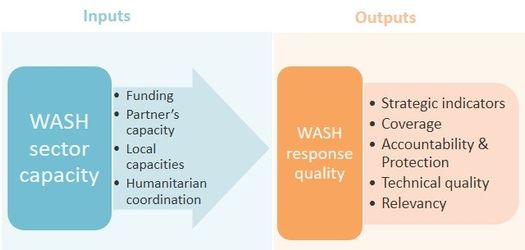What is it about?
Once the strategic and monitoring frameworks have been set up, and the monitoring tools and templates prepared, implementation must be carefully monitored by WASH coordination unit. It is responsible to monitor both response inputs (verifying that they are adequate) and response outputs (ensuring a maximal response quality), against targets defined in the WASH Operational Response Plan and Strategic Operational Framework (SOF).
The responsibilities of the WASH coordination platform regarding monitoring are summarized as follows, with links to relevant sections of this chapter as well as other chapters of the CTK
- Set up the WASH response monitoring plan
- Roll out the activity reporting tools (W-matrix)
Monitor response inputs:
Monitor WASH response funding status
Coordinate WASH sector capacity mapping
- Monitor the WASH coordination performances, including the achievements of the Minimum Requirements for National Humanitarian WASH Coordination Platforms
Monitor response outputs:
- Monitor WASH response progress against strategic indicators
- Monitor WASH response's geographical coverage
- Monitor the adherence of the response to the 5 WASH commitments on protection
- Monitor technical quality of the WASH services delivered to beneficiaries
- Monitor the relevancy of WASH response strategy and selected implementation modalities
What are the objectives?
- Ensure that organizations involved in the response remain accountable to affected people, national authorities and donors;
- Assess and adjust the humanitarian community’s response to a changing environment.
- Ensure WASH response is implemented according to agreed strategy and quality standards by taking corrective action when required.
| Warning | |||||
|---|---|---|---|---|---|
At least you should do...
|
Navigate in the sub-pages:
| Page Tree | ||
|---|---|---|
|
Finally, the WASH coordination platform consolidates and analyses monitoring results to identify response gaps (quality, coverage...) and ensure they are addressed through advocacy. This will be addressed separately in the Gap analysis & advocacy chapter.
